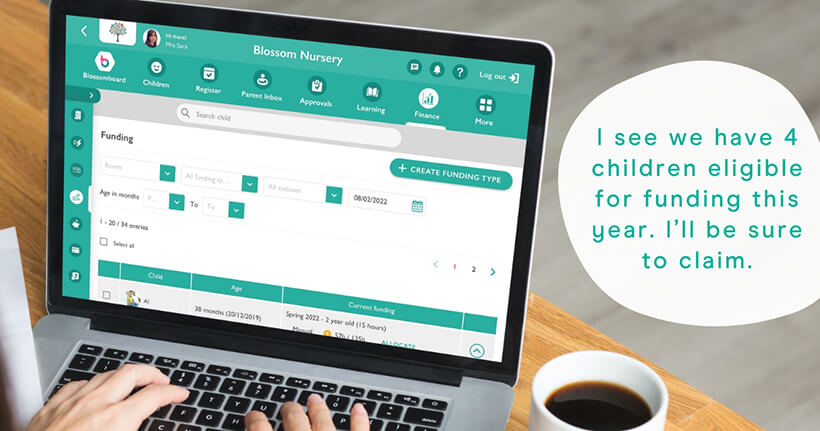When running or setting up a new nursery, mistakes will be inevitable. Some might include financial decisions and choices that can have a significant impact on the success of your nursery or childcare setting. In this article, we share advice and tips from Ash Pajpani, Owner of Inspire Montessori and Blossom Tree Montessori, on how to avoid the most common financial mistakes nursery owners make.
Meet the expert: Ash Pajpani

Ash Pajpani, Owner of Inspire Montessori and Blossom Tree Montessori, Director and Co-founder of Blossom Educational shares his advice and tips for financial success in nurseries. With over 10 years leadership experience across several EYFS settings, Ash has supported his nurseries through Outstanding Ofsted inspections. There’s not much Ash doesn’t know about financial strategies and how to use effective management tools to help optimise your nursery setting.
The top three common financial mistakes made by nursery schools
Nursery owners and managers can become bogged down with one aspect of budgeting or financial planning, missing the big-picture for their financial visibility.
It is important nursery managers are aware of every part of the financial picture within their settings; effective financial planning relies on visibility across all things finance.

The importance of having a financial plan for each month and each year cannot be underestimated. Nursery owners and managers must ensure they have a clear plan for spending and revenue each month, building into the bigger annual plan. These goals and plans are what drive every strategic decision from menu choices to practitioner hire. Nursery owners can make the mistake of running their childcare business month-to-month with no annual and even five-year plan in place.
Staffing is a nursery’s largest outgoing cost, it can account for up to 80% of your nursery budget. Common mistakes nursery managers and owners make can centre around staffing. Overstaffing and having too many practitioners in one room is a luxury most nurseries and childcare providers are not facing. Although unlikely your nursery will be overstaffed for the whole day, hours surrounding pick-up times can go over ratio if full staffing rotas aren’t managed carefully.
More commonly, understaffing may be a challenge for your setting. Impacting the number of children you are able to register for each day whilst remaining within the statutory required ratio. The level of education offered to your children should be your priority, your monthly budget for the staffing necessary to achieve these standards should be non-negotiable. This is where Blossom’s staff rota is a powerful tool as it supports your staff planning to ensure you’re never under- or over-staffed again.

Mistakes to avoid as a first-time nursery owner
There can be a perceived level of quality and value, if your prices are cheap; parents can question why and be concerned with the offer their child will be receiving. Don’t make the mistake of being afraid to charge what is necessary to offer an outstanding provision to the children in your care. Ensure you regularly communicate the outstanding level of care their child enjoys at your setting with Blossom’s Parent App. Sharing a photo, video or Golden moment their child experienced that day – sent directly to a parent’s phone – can confirm the high standard of care offered. And therefore, there are appropriate fees to continue this.
Charging the correct amount is something learnt through experience of owning nurseries. In my early days I felt I needed to be competitive with other local nurseries but it meant sacrificing other aspects in order to achieve the standard of education I wanted for the children in my care.

The best nursery management tools and strategies to try
Which is more important to a nursery manager or owner, helpful tools or strategies to help optimise a nursery’s success? The answer is both; they go hand in hand when successfully running a childcare business. Management tools can be free or paid for, and should reduce the time, effort or complexity of tasks managers regularly undertake (invoicing software, communication tools, financial report software). Nursery management strategies are the overarching methods of working that run your childcare business (budget management, strategic decisions).
Ash suggests a simple, yet effective strategy of knowing your historical spending in each area. For example, if you spend 10% of your annual revenue on the maintenance of play equipment, this can be budgeted for the next financial year. When your childcare business grows and begins earning more revenue, this percentage figure is able to stay the same, the percentage is unchanged, but the actual amount may vary due to income.
Managing and owning a nursery requires a number of ‘hats’ to be worn: leadership, strategic direction, and budget management, to name a few. Naturally, you will have areas of management you enjoy more than others. Financial management may not be one of your favourite ‘hats’, but it is necessary to successfully run your childcare business. Don’t make the mistake that, as the nursery manager or owner, you have to undertake your nursery’s finances alone. An effective strategy can be using nursery software to help you with important tasks, such as invoicing support, HR and staff management, or financial annual revenue reports.
The most valuable management tool I have come across as a nursery owner for over 10 years has to be Blossom’s staffing feature. It really is fantastic. I have a handle on all rotas, qualifications, observations completed, and any timetable requests are as easily available to me as checking a WhatApp message.

The annual revenue report feature is invaluable for helping me with full visibility of my nurseries’ finances, staffing structures and invoicing. I can set targets and aims for my nursery’s growth today for the end of the year so easily.

Paperless billing: what are the benefits?
Paperless billing is a game changer for nursery owners and managers, saving a huge amount of time on the associated admin whilst making the overall experience for parents easier to manage. Paper-based invoices require more stringent monitoring processes to ensure correct calculations, contact information, not to mention the follow-up admin for payment reminders. As a nursery manager or owner, continuing with paper-based billing methods is often a mistake, as by using nursery software, this one feature alone allows you to use your time effectively, removes the likelihood of human error and gives parents professional confidence in your nursery.
Paperless billing, paired with Blossom’s new BE paid feature which allows your parents to make payments via our Parent App, removes the hassle of the entire invoicing process. Meaning time can be spent on strategic decisions for your setting’s growth and success.

Funding mistakes made by nursery schools
Nurseries are busy settings, and it can be easy to let funding monitoring slip your mind. One of the most common EYFS funding mistakes nursery schools make is forgetting to claim the funding for those eligible. Another administrative task that can often be bumped down the priority list when your setting is due for an Ofsted inspection or preoccupied with recruitment of new staff.
Blossom’s filter and search features are extremely helpful when monitoring the funding claims you have submitted for your nursery children. By filtering via age (36-40 months for example), children eligible for funding can be quickly identified, making monitoring easier.

Top tips on how to manage deposits in nurseries
Nurseries commonly set the deposit amount at a month’s total cost for the hours they will be booked in for, or they may choose a rounded figure like £100. Ash warns of making the mistake of undercharging with deposits and encourages to consider the time, legal expenses and loss of profit from losing that space when weighing up the amount to set.
If your nursery experiences particularly high mobility rates of families, moving to another nursery could be likely, leaving your childcare setting with a space to fill at short notice. It is important to use a robust marketing and advertising system to fill the spaces in your nursery, being mindful of the school leavers and the availability they may leave. This is when using digital financial reporting tools are a nursery manager’s best friend, as you’re able to stay on track with deposits pending or refunded, fees forecasting, debts reports and more.
Some nurseries can undercharge when taking a deposit for a place. However, it is important to think of the bigger picture for your setting when deciding your deposit amount.

Take a peek at Blossom’s packages available to help your setting achieve financial success, or contact our UK-based customer success team today and book in a quick 15-minute demo.
Subscribe to receive expert advice and tips from seasoned professionals in the early years sector.